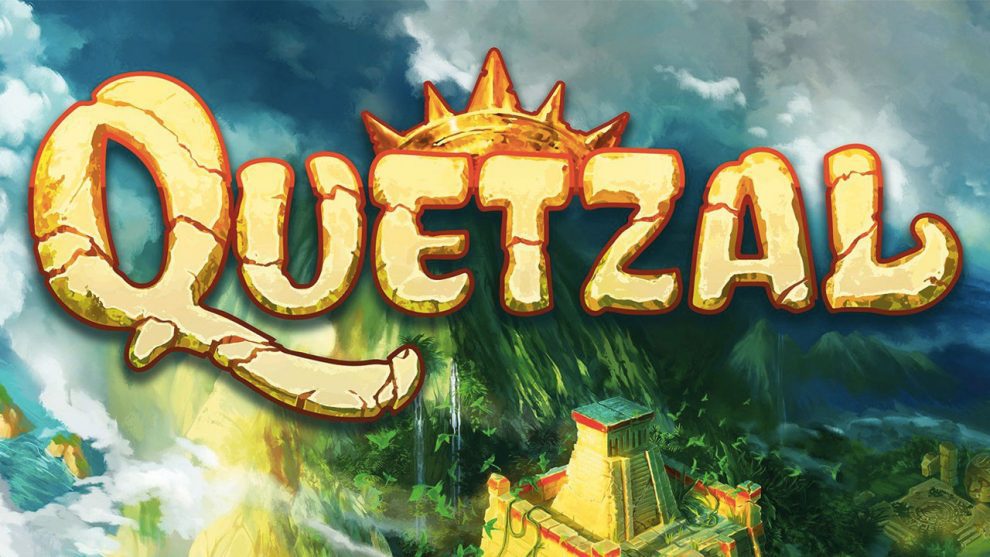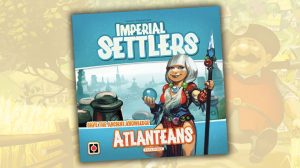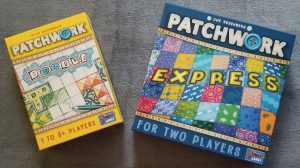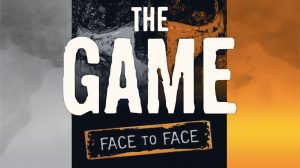Overview
In Quetzal, each player is leading a group of adventurers and archaeologists–meeples–on an adventure through the ruins of an ancient civilization. Each meeple is black on one side and white on the other and its color plays a factor in which actions you are able to perform with it. At the start of a round the players will roll their meeples (just like chucking dice) to determine the makeup of their party for the round and then take turns assigning their meeples to the various action locations in order to earn money, collect artifact cards, and deliver said artifacts for victory points. After 5 rounds the game comes to an end and the player that has managed to score the most points wins.
Of course this is a high level overview of the game. If you’re just interested in what I think, feel free to skip ahead to the Thoughts section. Otherwise, read on as I tell you how to play Quetzal.
Setup
Each player selects a color and takes the wooden pieces and Character tile of their chosen color as well as some starting cash. One of their wooden markers is placed on the 0 of the Score track and the other is placed on the 0 of the Discovery track.
Next, all of the Artifact cards are shuffled into a deck and 14 of them are drawn and placed into each Artifact location, the Round marker is placed on the 1 position of the Round track, and the Upgrade tiles are shuffled with 3 of them being placed into their appropriate locations on the game board. Some locations will have tiles that cover them up at lower player counts.

Once this is all set up, a starting player is selected and given the First Player marker and you are ready to begin playing Quetzal.
Roll Those Sacks of Bones
In Phase 1 of the round, the players will scoop up all of their meeples (their workers as well as their Character meeple), shake them up in their hands, and then toss them onto the playing area like dice. Any that land on their backs are treated as whichever color is facing upwards. If any land on their sides, they count as wild and can stand in for either color during the placement. Likewise for any that land on their feet, but these also earn their owners a coin as well. The Character meeple is always considered to be wild.

Location, Location, Location
Phase 2, the placement phase, is where most of the game’s action occurs. During this phase, players will take turns assigning their workers to the various locations on the board. In general, there are 3 types of locations: unique, bidding, and free locations.
The unique locations–Stela of Knowledge, the Temple, the Black Market, and the Village–only accept meeples of certain colors.
The bidding locations–the Temple Surroundings, the Black Market, and the Ships–can accept meeples of any color. However, once a color has been used at that location, it is locked in and further meeples sent to that location must be of the same color. Any wilds sent to those locations become whichever color is already present or the player selects a color for that wild to become if no other colors are present. Furthermore, if meeples are already present at the location, then a player sending meeples there must send more than are currently on that spot. The meeples that were already there are kicked out and returned to their owner’s supply (their colors are not changed). Of these locations, only the Black Market straddles the line between unique locations and bidding locations.
The free locations–the Camp and Harbor Master’s Office, can accept meeples of any color regardless of what may already be present there.

Here is a brief rundown of the locations and what they do (in the same order that each is assessed during the third phase):
Stela of Knowledge – The player receives the first player marker and a movement on the Discovery track.
The Temple – The players pay coins to receive Artifact cards. Some spots reward face up cards, other spots reward cards drawn from the deck, while others reward a mixture of the two.
The Temple Surroundings – Each of these locations rewards the highest bidder with the two cards shown and either a coin, a Discovery track movement, or a victory point.
The Black Market – This location allows the highest bidder to discard an Artifact card from their hand for 7 coins.
The Village – The players pay coins to take 1 of the face up Upgrade tiles. A player’s Character tile can only hold 2 face up tiles at a time. If they already have 2 tiles, then they must replace one of them. That tile is kept face down to the left of the Character tile and will be worth a number of victory points at the end of the game.
The Harbor Master’s Office – A player can spend 2 coins to send a meeple here. This will allow them to deliver 3 Artifact cards during the third phase.
The Ships – These locations will award the highest bidder with the ability to deliver 6 Artifact cards.
The Camp – The player takes a coin from the supply and can re-roll one of their meeples. If the newly rolled meeple lands on its feet, its owner receives another coin. This location is a special case and activates immediately when a meeple is sent to it.
Workers Gonna Work
In the third phase, each location is resolved in numerical order (going from the top down in the case of the Temple and the Village locations). As a player resolves an action, their worker is removed from it. After the players have resolved the Village location and taken their Upgrade tiles, it’s time to start delivering Artifacts.
Each Artifact card has a specific type and the more of the same type the player can deliver at a time (up to a maximum of 3), the more victory points they will earn for delivering them. Players can mix and match Artifact cards when delivering them, but this is less efficient and earns fewer victory points. Some Artifact cards also have bonus icons in their upper right corners and reward these bonuses as the cards are delivered.

Once all of the workers have been removed, the Round marker advances a step, all of the empty Artifact card spaces are refilled with cards drawn from the deck, and the Village spaces are refilled with new Upgrade tiles. If it’s the end of the 5th round, the game is over and you move on to final scoring.
This Is the End
The owner of the First Player marker scores 2 points. Each player earns 1 point for every 3 coins they have leftover and however many points are printed on all of the Upgrade tiles they have collected. These are added to any points the players have scored over the course of the game and whoever has the highest total wins.
Thoughts
Back in 2017 my wife and I attended our very first Gen Con in Indianapolis. On our third evening there, we ate at a restaurant called St. Elmo’s Steakhouse, an establishment famous for their shrimp cocktail. Upon learning this, we decided to order a couple of these shrimp cocktails to see what all of the fuss was about. We figured we enjoy shrimp cocktail, so the likelihood of us enjoying world-famous shrimp cocktail was pretty high.
We were wrong. So wrong.
St. Elmo’s shrimp cocktail is the spiciest thing that I have ever put into my mouth. There’s a line between “being spicy and tasting good” and “being so spicy that it’s painful” that one should never cross when cooking, and St. Elmo’s gleefully leaps across that line. My mouth was beyond “on fire”. My nasal passages felt like they were melting. My tongue just gave up. I think my brain figured that it’d be easier to just turn off all of those nerve endings rather than deal with that amount of pain. There was nothing pleasant about that experience at all. At first glance, it seemed like something we’d enjoy, but after the fact, we both agreed that we were in no hurry to ever repeat that experience again.
That’s the same kind of feeling that I’m left with after playing Quetzal. Reading about the game, everything about it sounds like something that would be right up my alley–worker placement, bidding, set collection, and even an intriguing ‘meeple rolling’ mechanic–but the actual experience comes with so much baggage attached that it’s ultimately one that I am in no rush to repeat ever again.
The issue begins before you’ve even opened the box. The game’s subtitle reads “The City of Sacred Birds” and you’d be right to think that birds might play a role in the game. But you’d also be entirely wrong. Aside from an icon that kinda sorta looks like it could be a bird, Quetzal has nothing whatsoever to do with avians of any sort; a minor irritation, but an irritation nonetheless.
Upon opening the box, you are immediately presented with another such irritation and this one is component related. The box insert is designed in such a way that there is a one inch border around the insides of the box, creating a sort of well that the folded game board and components can fit inside of. However, the rule book is the same dimensions as the inside of the box without the border. This means that, after having punched the pieces and removed the empty sprue, the rule book kind of sits on top awkwardly dipping in the middle. Why the rule book doesn’t also fit inside of the well is beyond me. Like I said, though, this is a minor quibble. The thematic and mechanical issues I have with this game, however, go much deeper than skin deep.

Firstly, there’s the troublesome “looting ancient ruins for your own personal gain” aspect of the narrative. This is little different from the problem of colonialism that Thomas Wells speaks about in his “What Are We Playing At?” article. Exploring and understanding the inner workings of an ancient civilization (a la Lost Ruins of Arnak) isn’t problematic. Loading up the loot that we find and shipping it off for victory points or money, however, is. The rule book just glosses right over this aspect of the narrative, never paying it any thought or even acknowledging that it exists. It seems that the designers were so hyper-focused on the game and its mechanics that they lost sight of what the game is actually about, and that isn’t okay. In this day and age, we’ve got to do better. We’ve got to BE better.
And speaking of mechanics, what’s the deal with rolling meeples? It was this mechanic that intrigued me the most when I first heard about Quetzal and I was really hoping that something interesting would be done with it. I tried to design a game several years ago with a meeple rolling mechanic, but I just couldn’t figure out how to make it work in a way that would make someone actually want to play my game, so I put it onto the back burner. I was excited to see how Quetzal was going to handle it.
It handled it very poorly. The issue that I have isn’t so much with the rolling of the meeples itself. It’s with the fact that there’s really no point in rolling them. When you roll your meeples, you come up with one of three possible outcomes: a black meeple, a white meeple, or a wild. Ultimately, though, these meeples are performing the same actions, so there’s nothing really distinguishable about them. What’s the difference between an ‘adventurer’ going to the temple to collect some cards versus an ‘archaeologist’ going to the temple to collect some cards? There’s nothing thematically that sets these titles apart. As a result, it just winds up feeling very same-y and that really bothers me. It feels like a mechanic that was tacked onto the game just to give the game something unique that it could point to.
I wish there were more sections of the board where only adventurers could go and others where only archaeologists could go so that deciding between them would be an agonizing decision. Sure, the Black Market action can only be used by a black worker and the Stela of Knowledge can only be activated by a white worker, but it’s just not enough. It never really feels like your decisions really matter. And that’s probably my biggest gripe of all: a lack of interesting choices.
Quetzal ultimately comes down to two things: collecting cards and selling cards. The cards that you are able to collect largely come down to mostly unmitigatable luck. You roll your meeples and hope for the best. The only mitigation comes in the form of The Camp which costs you a worker in order to reroll another one. There is no method of giving up something now for a better result at some other point in time (like in The Castles of Burgundy, for example). There is no built-in conversion rate (à la Catan) either so that you can manipulate your worker selection. You never gain additional workers to your pool. Nope, you’re just stuck with whatever you wind up with and the choices of what to do with those workers are always fairly obvious.
For instance, if you’ve got a large collection of cards in hand, then you send exactly one of whichever color you have the most of to the spot that will let you deliver the most cards and then you work your way backwards from there. If you get outbid, then you go back with even more workers and, if you don’t have enough to win back the spot, then you send workers to the Camp until you have enough money to send a worker to the Harbor Master’s Office because delivering only 3 cards is better than delivering none at all. This sequence of events never changes. It all feels very formulaic.
Don’t get me wrong. I don’t hate Quetzal. Not by a longshot. I just don’t love it. It’s a decent game. It’s just that there are so many better games out there with a similar theme that I DO love–the aforementioned Lost Ruins of Arnak or Reiner Knizia’s The Quest For El Dorado, for instance–that it’s hard to justify bringing out this game with so many niggling issues versus bringing out one of those instead. Your mileage may vary, though. Quetzal might be just the introductory worker placement game you’ve always wanted. Fortunately, this isn’t one of those games that you’ve got to buy and hope for the best. It’s available to play on Board Game Arena right now for free so you can give it a try before you buy. As for me, I don’t think I’ll be joining you.












Add Comment